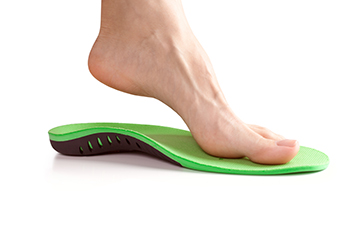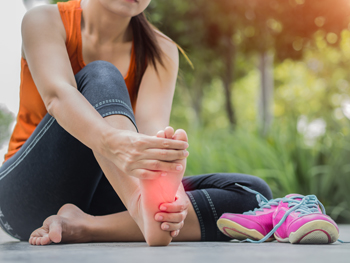6734 Lankershim Blvd
North Hollywood, CA 91606

Shoe orthotics are not just for athletes or people with foot pain, they can benefit anyone whose feet are not functioning at their best. Custom orthotics are specially designed to support your unique foot structure, helping to correct alignment, absorb shock, and improve balance. You might need them if you suffer from chronic heel pain, arch problems, flat feet, or conditions like plantar fasciitis or arthritis. Even knee, hip, or back pain can sometimes be traced back to poor foot mechanics. Unlike over-the-counter inserts, custom orthotics are made from molds of your feet, so they address your specific needs. They can fit in many types of shoes and help reduce fatigue during everyday activities. If your feet ache or you feel unsteady on your feet, it is suggested that you see a podiatrist who can assess your gait and recommend whether orthotics could improve your comfort and long-term foot health.
If you are having discomfort in your feet and would like to try orthotics, contact Dr. Jennifer Woo from California. Our doctor can provide the care you need to keep you pain-free and on your feet.
What Are Orthotics?
Orthotics are inserts you can place into your shoes to help with a variety of foot problems such as flat feet or foot pain. Orthotics provide relief and comfort for minor foot and heel pain but can’t correct serious biomechanical problems in your feet.
Over-the-Counter Inserts
Orthotics come in a wide variety of over-the-counter inserts that are used to treat foot pain, heel pain, and minor problems. For example, arch supports can be inserted into your shoes to help correct overarched or flat feet, while gel insoles are often used because they provide comfort and relief from foot and heel pain by alleviating pressure.
Prescription Orthotics
If over-the-counter inserts don’t work for you or if you have a more severe foot concern, it is possible to have your podiatrist prescribe custom orthotics. These high-quality inserts are designed to treat problems such as abnormal motion, plantar fasciitis, and severe forms of heel pain. They can even be used to help patients suffering from diabetes by treating foot ulcers and painful calluses and are usually molded to your feet individually, which allows them to provide full support and comfort.
If you are experiencing minor to severe foot or heel pain, it’s recommended to speak with your podiatrist about the possibilities of using orthotics. A podiatrist can determine which type of orthotic is right for you and allow you to take the first steps towards being pain-free.
If you have any questions please contact our office located in North Hollywood, CA . We offer the newest diagnostic and treatment technologies for all your foot and ankle needs.

Outer foot pain while running can disrupt performance and indicate underlying foot issues. Several causes may contribute to this discomfort. Blisters, often caused by friction or ill-fitting shoes, can create surface pain along the foot's outer edge. Bunions, although typically near the big toe, can alter foot mechanics and lead to lateral discomfort. Flat feet may cause instability, placing strain on the outer foot, while high arches can lead to poor shock absorption and excessive pressure on that same area. Another possible cause is Morton’s neuroma, a painful condition involving nerve irritation usually felt in the forefoot but occasionally radiating outward. If you enjoy running and have developed foot pain, it is suggested that you contact a podiatrist who can provide an accurate diagnosis and treatment.
Foot Pain
Foot pain can be extremely painful and debilitating. If you have a foot pain, consult with Dr. Jennifer Woo from California. Our doctor will assess your condition and provide you with quality foot and ankle treatment.
Causes
Foot pain is a very broad condition that could be caused by one or more ailments. The most common include:
Diagnosis
To figure out the cause of foot pain, podiatrists utilize several different methods. This can range from simple visual inspections and sensation tests to X-rays and MRI scans. Prior medical history, family medical history, and any recent physical traumatic events will all be taken into consideration for a proper diagnosis.
Treatment
Treatment depends upon the cause of the foot pain. Whether it is resting, staying off the foot, or having surgery; podiatrists have a number of treatment options available for foot pain.
If you have any questions, please feel free to contact our office located in North Hollywood, CA . We offer the newest diagnostic and treatment technologies for all your foot care needs.

A bunion is more than a bump on the side of the foot. It is a misalignment of the joint at the base of the big toe, which can lead to swelling, redness, and persistent pain. Bunions often develop slowly and may be caused by inherited foot structure, arthritis, or wearing tight shoes that crowd the toes. Early treatment focuses on relieving discomfort and slowing the progression of the deformity. Wearing shoes with a wide toe box and using protective pads can reduce pressure and inflammation. Custom orthotics may help correct foot mechanics and ease strain on the joint. In cases where pain interferes with daily activities, surgical options may be considered to realign the toe and restore function. If you are struggling with bunion pain or notice the deformity is worsening, it is suggested that you see a podiatrist for a proper diagnosis and treatment tailored to your needs.
If you are suffering from bunions, contact Dr. Jennifer Woo of California. Our doctor can provide the care you need to keep you pain-free and on your feet.
What Is a Bunion?
A bunion is formed of swollen tissue or an enlargement of boney growth, usually located at the base joint of the toe that connects to the foot. The swelling occurs due to the bones in the big toe shifting inward, which impacts the other toes of the foot. This causes the area around the base of the big toe to become inflamed and painful.
Why Do Bunions Form?
Genetics – Susceptibility to bunions are often hereditary
Stress on the feet – Poorly fitted and uncomfortable footwear that places stress on feet, such as heels, can worsen existing bunions
How Are Bunions Diagnosed?
Doctors often perform two tests – blood tests and x-rays – when trying to diagnose bunions, especially in the early stages of development. Blood tests help determine if the foot pain is being caused by something else, such as arthritis, while x-rays provide a clear picture of your bone structure to your doctor.
How Are Bunions Treated?
If you have any questions, please feel free to contact our office located in North Hollywood, CA . We offer the newest diagnostic and treatment technologies for all your foot care needs.